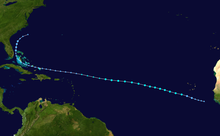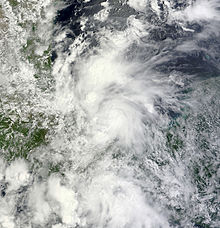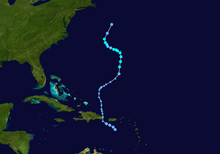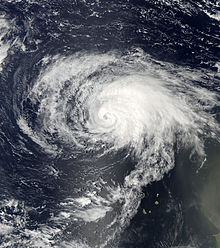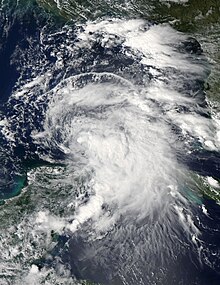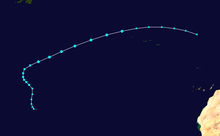| Timeline of the 2013 Atlantic hurricane season | |||||
|---|---|---|---|---|---|
 Season summary map | |||||
| Season boundaries | |||||
| First system formed | June 5, 2013 | ||||
| Last system dissipated | December 7, 2013 | ||||
| Strongest system | |||||
| Name | Humberto | ||||
| Maximum winds | 90 mph (150 km/h) (1-minute sustained) | ||||
| Lowest pressure | 979 mbar (hPa; 28.91 inHg) | ||||
| Longest lasting system | |||||
| Name | Humberto | ||||
| Duration | 11 days | ||||
| |||||
The 2013 Atlantic hurricane season was an event in the annual hurricane season in the north Atlantic Ocean. It featured below-average tropical cyclone activity,[nb 1] with the fewest hurricanes since the 1982 season.[2] The season officially began on June 1, 2013 and ended on November 30, 2013. These dates, adopted by convention, historically delimit the period in each year when most tropical systems form.[3] The season's first storm, Tropical Storm Andrea formed on June 5, and its final storm, an unnamed subtropical storm, dissipated on December 7. Altogether, there were 13 named tropical storms during the season. Two of which attained hurricane strength, but neither intensified into a major hurricane,[nb 2] the first such occurrence since the 1994 season.[2]
Despite the season's below-average activity overall, three Atlantic storms made Landfall in Mexico, two as tropical storms and one as a hurricane.[nb 3] Hurricane Ingrid made landfall on September 15, near La Pesca, Tamaulipas, on September 15, killing 23 and causing $1.5 billion (2013 USD) in damage. That same month, on the opposite side of the country, Hurricane Manuel made multiple landfalls along Mexico's Pacific coast, causing catastrophic damage.[5] The only tropical storm to make landfall in the United States was Andrea. After coming ashore in Florida's Big Bend region, it killed at least three and brought tornadoes, heavy rainfall, and flooding to a large section of the U.S. East Coast and Atlantic Canada.[6][7]
This timeline documents tropical cyclone formations, strengthening, weakening, landfalls, extratropical transitions, and dissipations during the season. It includes information that was not released throughout the season, meaning that data from post-storm reviews by the National Hurricane Center, such as a storm that was not initially warned upon, has been included.
By convention, meteorologists use one time zone when issuing forecasts and making observations: Coordinated Universal Time (UTC), and also use the 24-hour clock (where 00:00 = midnight UTC).[8] The National Hurricane Center uses both UTC and the time zone where the center of the tropical cyclone is currently located. The time zones utilized (east to west) prior to 2020 were: Atlantic, Eastern, and Central.[9] In this timeline, all information is listed by UTC first with the respective regional time included in parentheses. Additionally, figures for maximum sustained winds and position estimates are rounded to the nearest 5 units (knots, miles, or kilometers), following the convention used in the National Hurricane Center's products. Direct wind observations are rounded to the nearest whole number. Atmospheric pressures are listed to the nearest millibar and nearest hundredth of an inch of mercury.



